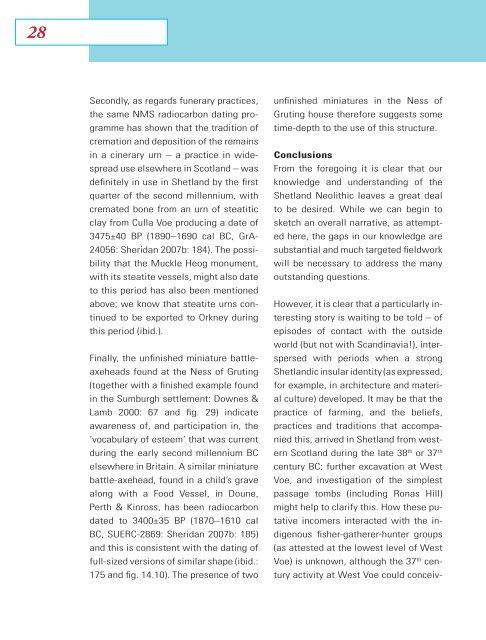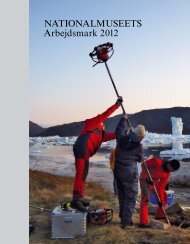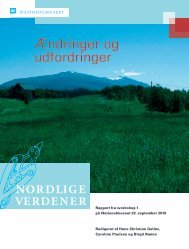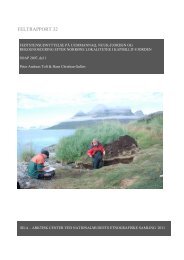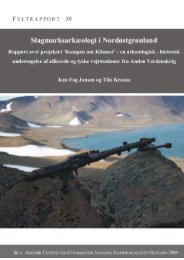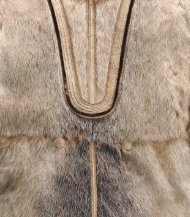The Border of Farming and the Cultural Markers - Nordlige Verdener
The Border of Farming and the Cultural Markers - Nordlige Verdener
The Border of Farming and the Cultural Markers - Nordlige Verdener
Create successful ePaper yourself
Turn your PDF publications into a flip-book with our unique Google optimized e-Paper software.
28<br />
Secondly, as regards funerary practices,<br />
<strong>the</strong> same NMS radiocarbon dating programme<br />
has shown that <strong>the</strong> tradition <strong>of</strong><br />
cremation <strong>and</strong> deposition <strong>of</strong> <strong>the</strong> remains<br />
in a cinerary urn – a practice in widespread<br />
use elsewhere in Scotl<strong>and</strong> – was<br />
definitely in use in Shetl<strong>and</strong> by <strong>the</strong> first<br />
quarter <strong>of</strong> <strong>the</strong> second millennium, with<br />
cremated bone from an urn <strong>of</strong> steatitic<br />
clay from Culla Voe producing a date <strong>of</strong><br />
3475±40 BP (1890–1690 cal BC, GrA-<br />
24056: Sheridan 2007b: 184). <strong>The</strong> possibility<br />
that <strong>the</strong> Muckle Heog monument,<br />
with its steatite vessels, might also date<br />
to this period has also been mentioned<br />
above; we know that steatite urns continued<br />
to be exported to Orkney during<br />
this period (ibid.).<br />
Finally, <strong>the</strong> unfinished miniature battleaxeheads<br />
found at <strong>the</strong> Ness <strong>of</strong> Gruting<br />
(toge<strong>the</strong>r with a finished example found<br />
in <strong>the</strong> Sumburgh settlement: Downes &<br />
Lamb 2000: 67 <strong>and</strong> fig. 29) indicate<br />
awareness <strong>of</strong>, <strong>and</strong> participation in, <strong>the</strong><br />
‘vocabulary <strong>of</strong> esteem’ that was current<br />
during <strong>the</strong> early second millennium BC<br />
elsewhere in Britain. A similar miniature<br />
battle-axehead, found in a child’s grave<br />
along with a Food Vessel, in Doune,<br />
Perth & Kinross, has been radiocarbon<br />
dated to 3400±35 BP (1870–1610 cal<br />
BC, SUERC-2869: Sheridan 2007b: 185)<br />
<strong>and</strong> this is consistent with <strong>the</strong> dating <strong>of</strong><br />
full-sized versions <strong>of</strong> similar shape (ibid.:<br />
175 <strong>and</strong> fig. 14.10). <strong>The</strong> presence <strong>of</strong> two<br />
unfinished miniatures in <strong>the</strong> Ness <strong>of</strong><br />
Gruting house <strong>the</strong>refore suggests some<br />
time-depth to <strong>the</strong> use <strong>of</strong> this structure.<br />
Conclusions<br />
From <strong>the</strong> foregoing it is clear that our<br />
knowledge <strong>and</strong> underst<strong>and</strong>ing <strong>of</strong> <strong>the</strong><br />
Shetl<strong>and</strong> Neolithic leaves a great deal<br />
to be desired. While we can begin to<br />
sketch an overall narrative, as attempted<br />
here, <strong>the</strong> gaps in our knowledge are<br />
substantial <strong>and</strong> much targeted fieldwork<br />
will be necessary to address <strong>the</strong> many<br />
outst<strong>and</strong>ing questions.<br />
However, it is clear that a particularly interesting<br />
story is waiting to be told – <strong>of</strong><br />
episodes <strong>of</strong> contact with <strong>the</strong> outside<br />
world (but not with Sc<strong>and</strong>inavia!), interspersed<br />
with periods when a strong<br />
Shetl<strong>and</strong>ic insular identity (as expressed,<br />
for example, in architecture <strong>and</strong> material<br />
culture) developed. It may be that <strong>the</strong><br />
practice <strong>of</strong> farming, <strong>and</strong> <strong>the</strong> beliefs,<br />
practices <strong>and</strong> traditions that accompanied<br />
this, arrived in Shetl<strong>and</strong> from western<br />
Scotl<strong>and</strong> during <strong>the</strong> late 38 th or 37 th<br />
century BC; fur<strong>the</strong>r excavation at West<br />
Voe, <strong>and</strong> investigation <strong>of</strong> <strong>the</strong> simplest<br />
passage tombs (including Ronas Hill)<br />
might help to clarify this. How <strong>the</strong>se putative<br />
incomers interacted with <strong>the</strong> indigenous<br />
fisher-ga<strong>the</strong>rer-hunter groups<br />
(as attested at <strong>the</strong> lowest level <strong>of</strong> West<br />
Voe) is unknown, although <strong>the</strong> 37 th century<br />
activity at West Voe could conceiv-


